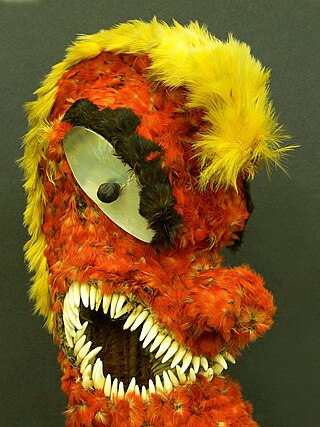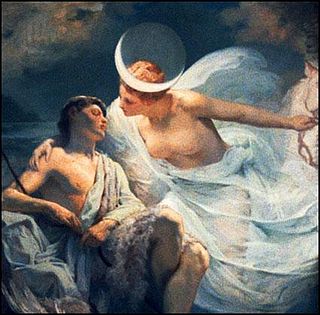Related Research Articles

Polynesian mythology encompasses the oral traditions of the people of Polynesia together with those of the scattered cultures known as the Polynesian outliers. Polynesians speak languages that descend from a language reconstructed as Proto-Polynesian – probably spoken in the Tonga and Samoa area around 1000 BC.
Tangaroa is the great atua of the sea, lakes, rivers, and creatures that live within them, especially fish, in Māori mythology. As Tangaroa-whakamau-tai he exercises control over the tides. He is sometimes depicted as a whale.
Ta'aroa is the supreme creator god in the mythology of the Society Islands of French Polynesia. While the use of the ʻeta is appropriate given the pronunciation of his name, it is often omitted in practice, as is typically the case with Tahitian words.
Atua are the gods and spirits of the Polynesian peoples such as the Māori or the Hawaiians ; the Polynesian word literally means "power" or "strength" and so the concept is similar to that of mana. Today, it is also used for the monotheistic conception of God. Especially powerful atua include:
Ao (daylight) is one of the primal deities who are the unborn forces of nature in Māori mythology. Ao is the personification of light, clouds, and the ordinary world, as opposed to darkness and the underworld.
In the traditions of ancient Hawaiʻi, Kanaloa is a god symbolized by the squid or by the octopus, and is typically associated with Kāne. It is also an alternative name for the island of Kahoʻolawe.

In Cook Islands mythology, Avatea was a lunar deity and the father of gods and men in Mangaian myth of origin. His eyes were thought to be the Sun and the Moon; he was also known as the god of light.
In Samoan mythology, Tagaloa is generally accepted as the supreme ruler, the creator of the universe, the chief of all gods and the progenitor of other gods. Tagaloa Lagi dwelt in space and made the Heavens the sky, the land, the seas, the fresh water, the trees and the people. Samoans believed Tagaloa created nine heavens. Tagaloa's role as paramount deity in the Samoa pantheon bears similarities to the position of Ta'aroa in Tahiti and Io Matua Kore in New Zealand.

A marae, malaʻe, meʻae or malae is a communal or sacred place that serves religious and social purposes in Polynesian societies. In all these languages, the term also means cleared and free of weeds or trees. Marae generally consist of an area of cleared land roughly rectangular, bordered with stones or wooden posts perhaps with paepae (terraces) which were traditionally used for ceremonial purposes; and in some cases, a central stone ahu or a'u. In the Rapa Nui culture of Easter Island, the term ahu has become a synonym for the whole marae complex.
Marama relates to more than one article:
Io Matua Kore is often understood as the supreme being in Polynesian native religion, particularly of the Māori people.
Rarohenga is the subterranean realm where spirits of the deceased dwell after death, according to Māori oral tradition. The underworld is ruled by Hine-nui-te-pō, the goddess of death and night. Additional occupants include guardians, gods, goddesses, holy chiefs and nobles (rangatira), and the tūrehu, who are described as celestial, fairy-like people. Rarohenga is predominantly depicted as a place of peace and light. As articulated by Māori ethnographer Elsdon Best: It is a place where darkness is unknown. "This is the reason why, of all spirits of the dead since the time of Hine-ahuone…, not a single one has ever returned hither to dwell in this world".

Māori mythology and Māori traditions are two major categories into which the remote oral history of New Zealand's Māori may be divided. Māori myths concern tales of supernatural events relating to the origins of what was the observable world for the pre-European Māori, often involving gods and demigods. Māori tradition concerns more folkloric legends often involving historical or semi-historical forebears. Both categories merge in whakapapa to explain the overall origin of the Māori and their connections to the world which they lived in.
This is an example of a family tree of the Māori gods showing the most important gods in Māori mythology.

In Hawaiian religion, Kū is one of the four great gods. The other three are Kanaloa, Kāne, and Lono. Some feathered god images or akua hulu manu are considered to represent Kū. Kū is worshiped under many names, including Kū-ka-ʻili-moku, the "Snatcher of Land". Rituals for Kūkaʻilimoku included human sacrifice, which was not part of the worship of other gods.

Cook Islands mythology comprises historical myths, legends, and folklore passed down by the ancient Cook Islanders over many generations. Many of the Cook Islands legends were recited through ancient songs and chants. The Cook Islands myths and legends have similarities to general Polynesian mythology, which developed over the centuries into its own unique character.

A lunar deity or moon deity is a deity who represents the Moon, or an aspect of it. These deities can have a variety of functions and traditions depending upon the culture, but they are often related. Lunar deities and Moon worship can be found throughout most of recorded history in various forms.
In antiquity, Cook Islanders practiced Cook Islands mythology, before widespread conversion by the London Missionary Society during the nineteenth century. In modern times, the Cook Islands are predominantly Christian, with the largest denomination being the Cook Islands Christian Church.
References
- ↑ Maori religion and mythology Part 2: Lunar Myths
- 1 2 3 Smith Craighill Handy, Edward (1927). Polynesian Religion (12 ed.). The Museum. pp. 35–101.
- ↑ Tregear, E (September 1893). "Asiatic Gods in the Pacific". The Journal of the Polynesian Society. 2 (3): 133–139 – via JSTOR.
- ↑ Dixon, Roland (1916). The Mythology of all Races (5 ed.). Marshall Jones. pp. 265–307.